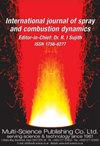有外火焰和无外火焰的旋流非预混火焰熄火特性及非定常动力学
IF 2.1
4区 工程技术
Q3 ENGINEERING, MECHANICAL
International Journal of Spray and Combustion Dynamics
Pub Date : 2023-11-07
DOI:10.1177/17568277231209133
引用次数: 0
摘要
利用平面激光诱导羟基荧光(OH-PLIF)技术,通过改变旋流条件,对火焰I、火焰II、火焰III三种旋流火焰进行了研究。根据PLIF结果,火焰I和火焰II存在双重结构。内火焰在内剪切层内燃烧,并被旋涡击穿锚定,类似于M型或v型火焰。独特的外火焰附着在空气环形喷嘴内壁上,在外剪切层燃烧。有外焰的旋流火焰贫爆当量比无外焰的低。比较这三种火焰与传统旋转火焰的LBO机制,研究它们的非定常特性是一项有趣的研究。首先,火焰I和II的熄灭过程是从外部火焰根部的局部熄灭开始的。而火焰III的LBO过程与传统旋流火焰的LBO过程是一致的,即从内部再循环区(IRZ)的根部开始反复灭火和重燃。其次,采用光谱固有正交分解法分析了三种火焰的非定常特性。发现在近lbo条件下,火焰振荡、不对称扰动和不同频率的纵向扰动以不同的组合形式存在。特别是不对称扰动和p波扰动主要存在于内剪切层和射流击穿,进一步说明了外火焰的稳定性和抗lbo潜力。本文章由计算机程序翻译,如有差异,请以英文原文为准。
Lean flameout characteristics and unsteady dynamics of swirling non-premixed flame with and without outer flame
The planar laser induced hydroxyl fluorescence (OH-PLIF) technique was used to study three kinds of swirling flame, namely flames I, II, and III, by changing swirl conditions. According to the PLIF results, double structure exists in flames I and II. The inner flame burns in the inner shear layer and is anchored by vortex breakdown, which is similar to the M- or V-shaped flame. The unique outer flame is attached to the inner wall of the air annular nozzle and burns in the outer shear layer. The lean blowout (LBO) equivalent ratio of swirling flame with outer flame is lower than that without outer flame. It is interesting to compare the LBO mechanisms among the three types and the traditional swirling flame, and investigate their unsteady characteristics. Firstly, the flameout process of flames I and II starts from the local extinguishing at the root of the outer flame. However, the LBO process of flame III is consistent with that of traditional swirling flame, that is, it starts with repeated extinguishing and reigniting at the root of the inner recirculation zone (IRZ). Secondly, the unsteady characteristics of the three flames are analyzed by spectral proper orthogonal decomposition. It is found that flame oscillations, asymmetric disturbances, and longitudinal disturbances of different frequencies exist in different combinations under near-LBO conditions. In particular, asymmetric and P-wave disturbances mainly exist in the inner shear layer and jet breaking down, which further indicates the stability and anti-LBO potential of the outer flame.
求助全文
通过发布文献求助,成功后即可免费获取论文全文。
去求助
来源期刊

International Journal of Spray and Combustion Dynamics
THERMODYNAMICS-ENGINEERING, MECHANICAL
CiteScore
2.20
自引率
12.50%
发文量
21
审稿时长
>12 weeks
期刊介绍:
International Journal of Spray and Combustion Dynamics is a peer-reviewed open access journal on fundamental and applied research in combustion and spray dynamics. Fundamental topics include advances in understanding unsteady combustion, combustion instability and noise, flame-acoustic interaction and its active and passive control, duct acoustics...
 求助内容:
求助内容: 应助结果提醒方式:
应助结果提醒方式:


